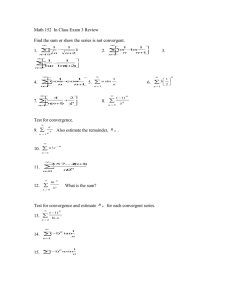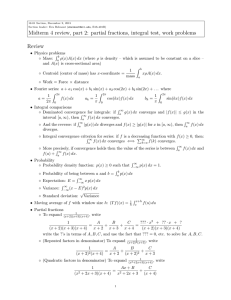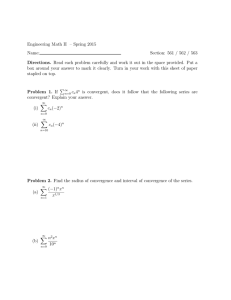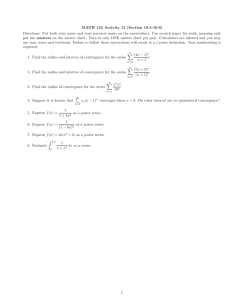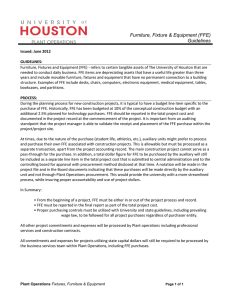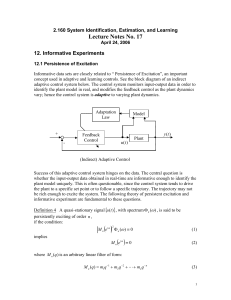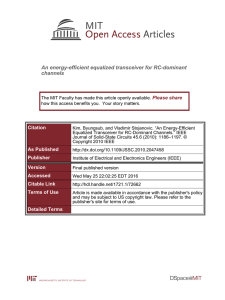MATH 267 Problem Set 11 Solutions The notation
advertisement
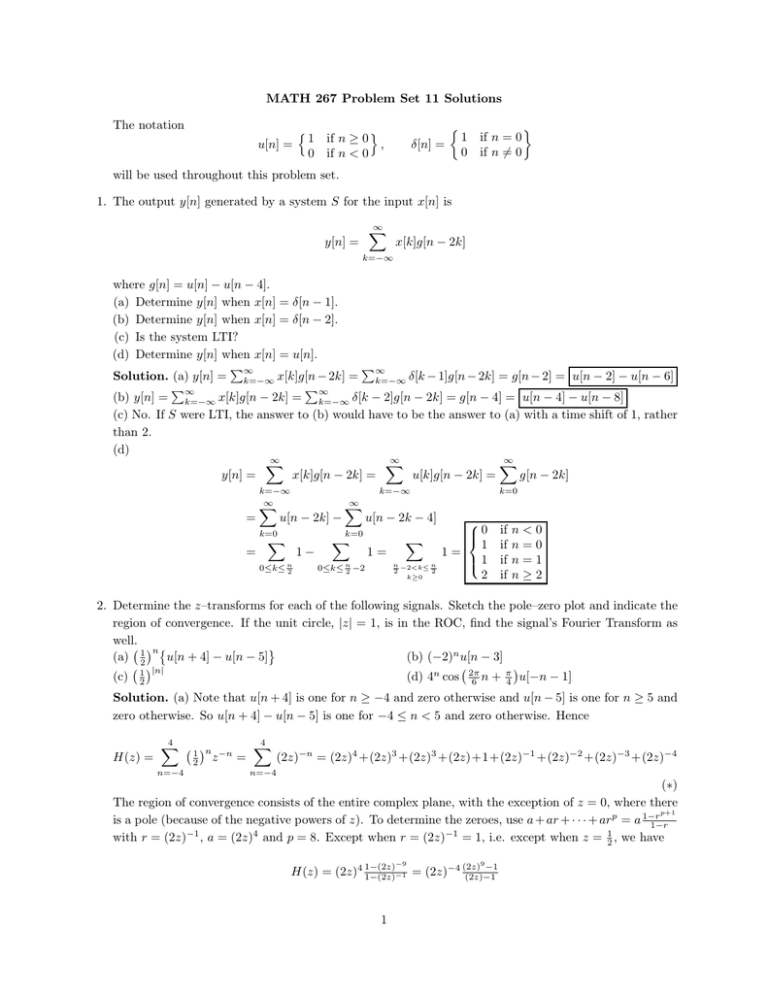
MATH 267 Problem Set 11 Solutions The notation u[n] = n 1 0 o if n ≥ 0 , if n < 0 δ[n] = 1 if n = 0 0 if n 6= 0 will be used throughout this problem set. 1. The output y[n] generated by a system S for the input x[n] is ∞ X y[n] = x[k]g[n − 2k] k=−∞ where g[n] = u[n] − u[n − 4]. (a) Determine y[n] when x[n] = δ[n − 1]. (b) Determine y[n] when x[n] = δ[n − 2]. (c) Is the system LTI? (d) Determine y[n] when x[n] = u[n]. P∞ P∞ Solution. (a) y[n] = k=−∞ x[k]g[n − 2k] = k=−∞ δ[k − 1]g[n − 2k] = g[n − 2] = u[n − 2] − u[n − 6] P∞ P∞ (b) y[n] = k=−∞ x[k]g[n − 2k] = k=−∞ δ[k − 2]g[n − 2k] = g[n − 4] = u[n − 4] − u[n − 8] (c) No. If S were LTI, the answer to (b) would have to be the answer to (a) with a time shift of 1, rather than 2. (d) ∞ ∞ ∞ X X X y[n] = x[k]g[n − 2k] = u[k]g[n − 2k] = g[n − 2k] = = k=−∞ ∞ X ∞ X k=−∞ k=0 k=0 u[n − 2k] − X 1− 0≤k≤ n 2 X k=0 u[n − 2k − 4] 1= X n −2<k≤ n 2 2 k≥0 0≤k≤ n 2 −2 0 if n < 0 1 if n = 0 1= 1 if n = 1 2 if n ≥ 2 2. Determine the z–transforms for each of the following signals. Sketch the pole–zero plot and indicate the region of convergence. If the unit circle, |z| = 1, is in the ROC, find the signal’s Fourier Transform as well. n (a) 12 u[n + 4] − u[n − 5] (b) (−2)n u[n − 3] |n| π (d) 4n cos 2π (c) 12 6 n + 4 u[−n − 1] Solution. (a) Note that u[n + 4] is one for n ≥ −4 and zero otherwise and u[n − 5] is one for n ≥ 5 and zero otherwise. So u[n + 4] − u[n − 5] is one for −4 ≤ n < 5 and zero otherwise. Hence H(z) = 4 X n=−4 1 n −n z 2 = 4 X (2z)−n = (2z)4 +(2z)3 +(2z)3 +(2z)+1+(2z)−1 +(2z)−2 +(2z)−3 +(2z)−4 n=−4 (∗) The region of convergence consists of the entire complex plane, with the exception of z = 0, where there p+1 is a pole (because of the negative powers of z). To determine the zeroes, use a + ar + · · · + arp = a 1−r 1−r with r = (2z)−1 , a = (2z)4 and p = 8. Except when r = (2z)−1 = 1, i.e. except when z = 12 , we have −9 9 1−(2z) −4 (2z) −1 H(z) = (2z)4 1−(2z) −1 = (2z) (2z)−1 1 So the zeroes of H(z) are 21 times the various 9th roots of unity, except z = 12 itself. (When z = 12 , H(z) is a sum of nine strictly postive terms and so cannot be zero. See (∗).) So the zeroes are z = 21 e2kπi/9 for iω 9 ) −1 k = 1, 2, 3, 4, 5, 6, 7, 8. Because |z| = 1 is in the region of convergence ĥ(ω) = H(eiω ) = (2eiω )−4 (2e (2eiω )−1 . (b) By definition ∞ X X(z) = x[n]z −n = n=−∞ ∞ X − 2 n z = (−2/z)3 1+2/z 8 = − z2 (z+2) n=3 provided − z2 | < 1. So the region of convergence is |z| > 2 . There are poles at z = 0, −2 and no zeroes. (The pole at z = 0 is not even on the boundary of the region of convergence and so can be legitimately discarded.) In this part |z| = 1 is not in the region of convergence. (c) ∞ X H(z) = 1 |n| −n z 2 = n=−∞ ∞ X 1 n −n z 2 −1 X + 1 −n −n z 2 = n=−∞ n=0 ∞ X (2z) −n − n=0 ∞ X z n 2 n=1 We made the substitution in n → −n in the second sum. Continuing, 1 1−(2z)−1 H(z) = − z/2 1−z/2 = 2z 2z−1 + z z−2 4z−5 = z 2(z−2)+(2z−1) (2z−1)(z−2) = z (2z−1)(z−2) 1 < 1, z < 1 or 1 < |z| < 2. There are poles at z = 1 , 2 and zeroes at with region of convergence 2z 2 2 2 iω −5 z = 0, 54 . Because |z| = 1 is in the region of convergence ĥ(ω) = H(eiω ) = eiω (2eiω4e −1)(eiω −2) . (d) The z–transform is H(z) = ∞ X h[n]z −n = n=−∞ = 1 −i π 4 2e −1 X 4n cos 2π 6 n + π 4 z −n = n=−∞ ∞ X m=1 m π ei 3 z4 + ∞ X 1 2 π π π π ei 3 m−i 4 + e−i 3 m+i 4 z m 4 where m = −n m=1 1 iπ 4 2e ∞ X m π e−i 3 z4 m=1 = π z 1 −i π 4 ei 3 2e 4 π 1 − ei 3 z4 + π z 1 iπ 4 −i 3 2e e 4 π 1 − e−i 3 z4 π π π π π π π π z ei 12 1 − e−i 3 z4 + e−i 12 1 − ei 3 z4 z ei 12 + e−i 12 − z4 ei 4 + e−i 4 = = π π π π 8 8 1 − ei 3 z4 1 − e−i 3 z4 1 − ei 3 z4 1 − e−i 3 z4 π − z4 cos π4 cos 12 z = π z π 4 1 − ei 3 4 1 − e−i 3 z4 π π provided e±i 3 z4 < 1. That is, provided |z| < 4. There are poles at e±i 3 z4 = 1 or equivalently, at π cos 12 π z = 4e±i 3 . There are zeroes at z = 0 and z = 4 . Because |z| = 1 is in the region of convergence cos π4 ĥ(ω) = H(eiω ) = π cos 12 − 14 eiω cos π4 1 iω e π π 4 1 − 14 ei 3 eiω 1 − 14 e−i 3 eiω 3. Let x[n] = (−1)n u[n] + αn u[−n − n0 ] Determine the constraints imposed on the complex number α and the integer n0 by the requirement that the z–transform of x[n] has region of convergence 1 < |z| < 2. 2 Solution. The z–transform of x[n] is X(z) = = ∞ X n=−∞ ∞ X x[n]z −n = (−z)−n + n=0 ∞ X (−z)−n + −n X0 α n z n=−∞ n=0 ∞ X = ∞ X (−z)−n + ∞ X α −m z where m = −n m=n0 n=0 z m α m=n0 The first sum converges for (−z)−1 < 1 or |z| > 1. The second sum converges for αz < 1 or |z| < |α|. So we need |α| = 2 . There is no constraint placed on n0 . 4. Use partial fractions and the fact that the z–transform of an u[n] is |z| > |a|, to find the inverse z–transform of X(z) = 1 − 13 z −1 , (1 − z −1 )(1 + 2z −1 ) 1 1−az −1 , with region of convergence |z| > 2 Solution. Write ζ = z −1 . Then X(z) = 1 − 13 ζ A B A(1 + 2ζ) + B(1 − ζ) = + = (1 − ζ)(1 + 2ζ) 1−ζ 1 + 2ζ (1 − ζ)(1 + 2ζ) with A and B determined by A(1 + 2ζ) + B(1 − ζ) = 1 − 31 ζ ⇐⇒ A + B = 1, 2A − B = − 13 ⇐⇒ A = 29 , B = Hence X(z) = 2 1 9 1−ζ + 7 1 9 1+2ζ ⇒ 3 x[n] = 29 u[n] + 79 (−2)n u[n] 7 9

